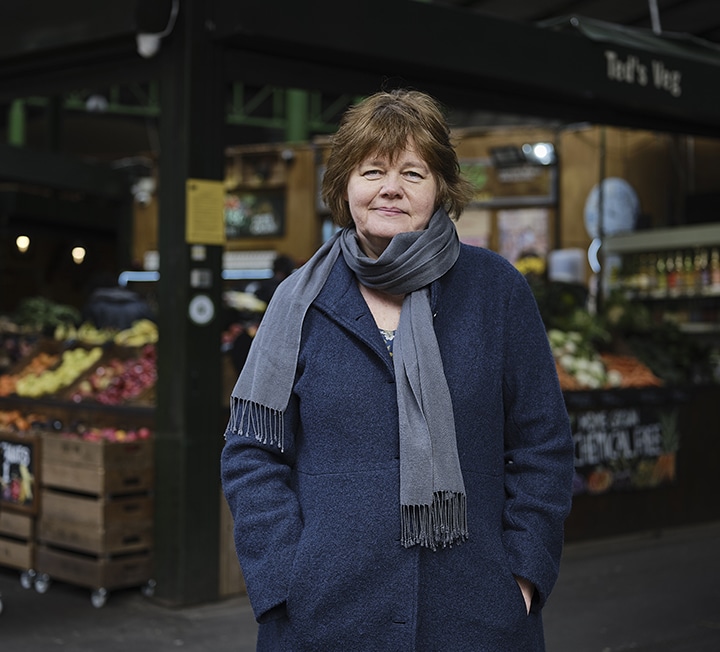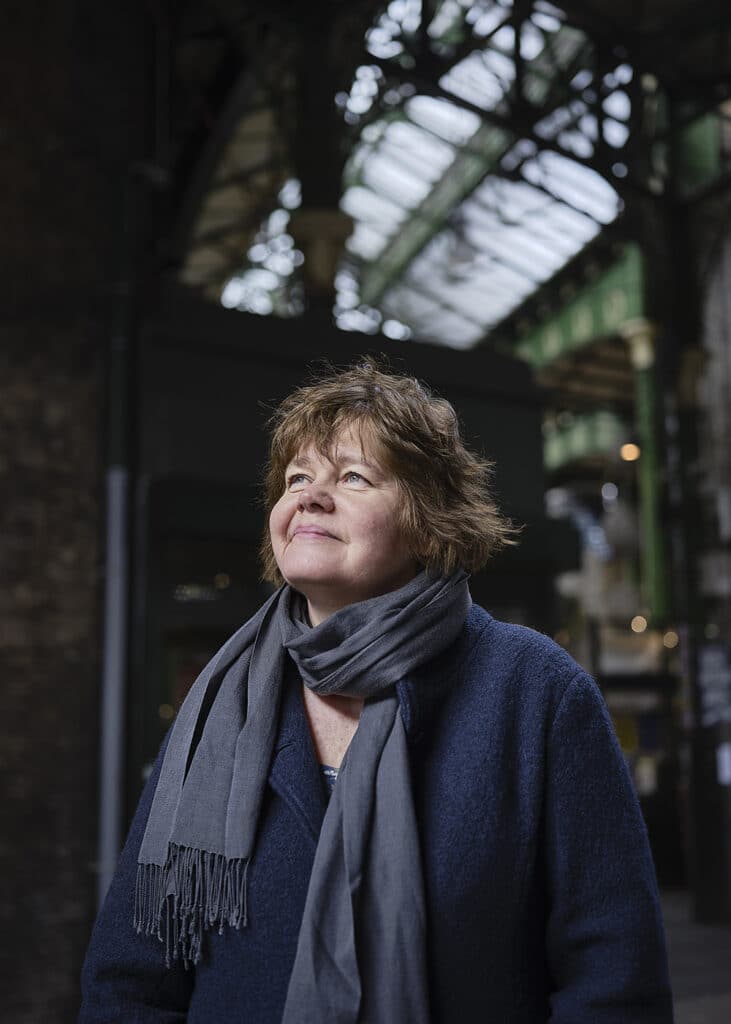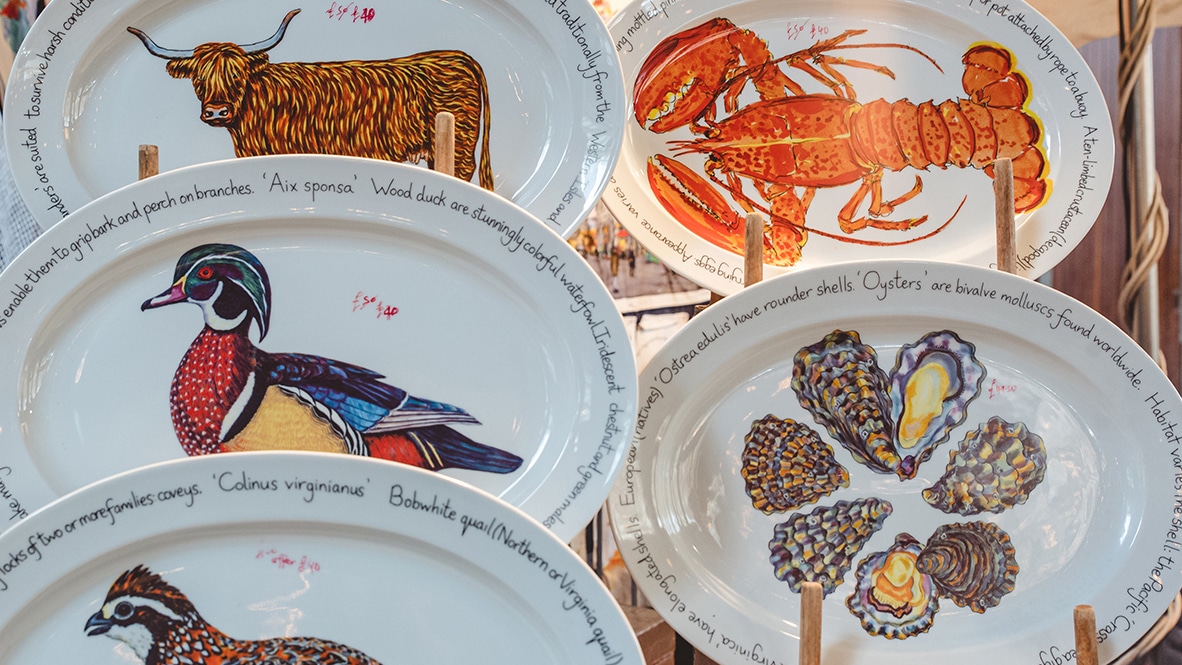Q&A: Carolyn Steel
Carolyn Steel, author of Hungry City and Sitopia, on the urban paradox, embracing nature, and why a good society is one in which everybody eats well


“WHEN MARKETS THRIVE, PEOPLE EAT WELL, FAMILY LIFE REVOLVES AROUND THE TABLE: THAT IS WHAT A GOOD LIFE IS ABOUT”
Interview: Ellie Costigan / Portrait: Orlando Gili
Carolyn Steel is an architect at heart. When I visit her London flat, once the tea is made (“first things first”), the next thing she does is get out a detailed plan, scribbled some eight years ago, mapping out the bare bones of her just-released second book, Sitopia. “I think spatially,” she concedes. An architect by training, Carolyn’s career has traversed posts at the London School of Economics, London Metropolitan University and Cambridge University, as well as journalism and presenting. The thread that joins all of her work together is a fascination with food: namely, how it shapes our lives and lived environments. Her first book, Hungry City, cemented her position as a leading thinker on the topic. Carolyn’s latest tome, Sitopia, places food firmly at the centre of solutions to the predicaments of the modern age, drawing on architecture, philosophy, literature, history, politics and science to get there.
Did you always have a strong interest in food?
Sort of. My grandparents owned a hotel in Bournemouth and we were there every other weekend. I remember being intrigued and excited by the contrast between the chaos of the kitchen – grease running down the walls and people shouting – and the rooms through the service door, where it was all “yes madam, no madam”, chandeliers and antique furniture. I remember loving that threshold – having the privilege of being able to walk between two worlds. It was completely magic. Clearly, from very early on in my life I was encountering a lot to do with food, but I would say my interest only really took shape in my early twenties, when I started reading about the history of food.
How did you make the leap from architecture to food?
As I started studying architecture I became conscious that there was something missing for me. That was the beginning of a long and painful 20-year search. I gradually realised that my interest lay in our relationship with buildings, how we live, rather than the buildings themselves. When I joined the London School of Economics as their first studio director, I was always trying to introduce disciplines that lay outside architecture. I realised people were still stuck in their silos, which drove me completely mad. When I left, almost in despair, I proposed to a colleague that we write a book on cities together. During that conversation, I had the idea of describing a city through food. It was the biggest lightbulb moment of my life – both my arms turned to chicken skin and my hair stood up on end. This is my thing! Food is my lens. I had the structure of Hungry City in less than a week.
Has studying architecture before coming to food given you an unusual perspective?
The ability to see where it’s all connected is definitely the skill of an architect – that helicopter vision. But I was completely paranoid the whole way through. Some of the stuff I was coming up with felt so obvious, like where I talk about how food shapes the city: why the meat was sold at Smithfield, why the veg was sold at Borough Market. I thought, I can’t be the only person writing about this; it can’t just be me doing this in my pyjamas, there must be a whole section in the library I’ve just not discovered. But there wasn’t. It was just me doing it in my pyjamas.
So, how was London shaped by food?
It was shaped by how food physically travelled to the city. When the Romans founded London, on the site of what is now the City, they set up the classic cardo and decumanus – the main north-south, east-west routes – and put the main market where they met. A no brainer. The site of the main market, the Roman forum, is where Leadenhall developed. Cheapside was an extension of that. The meat was coming in from the north and west – Scotland and Wales – getting fattened up in the suburbs and sold at Newgate. When Newgate got too small, it was sold in a ‘smooth field’ just outside of it: Smithfield. All the geese and turkeys from East Anglia would waddle into the city to be sold at the east side of the market at Poultry, which retains its name. Borough Market is at the end of London Bridge, which was the only bridge across the river until halfway through the 18th century, incredibly. It mainly sold fruit and veg, which was coming up from Kent, the key market garden of London.
Interestingly, the government had very little to do with feeding London. That’s the big difference between London and Paris: Paris tried to centralise its food in one place and control it. The English kings and queens just let the city get on with it. Then if they wanted to wage a war, they came begging to the city for money. It’s why London never had one centralised market, like Paris did. I often say it explains Brexit, though of course nothing really explains Brexit – this free trade attitude we have to feeding ourselves. The king never fed his people in this country, and that feels really significant.

You often use the phrase ‘urban paradox’. What do you mean by that?
There’s an inherent duality at the heart of how we should live as humans. We’re social, we have to be with one another to thrive, but we’re animals, which means that we need nature. How do you reconcile these two things? Actually, you can’t – and that’s the paradox. The more we gather in cities to be political or to be social, the further we get away from our source of sustenance, out in nature. Historically, utopian thinkers have tried to give you the best of both worlds: Aristotle, Thomas More, the amazing Ambrogio Lorenzetti’s The Effects of Good Governance, which is a painting of the city of Sienna and the countryside beyond, with a big red wall in between.
My latest book is called Sitopia, which means ‘food place’, and it was really a deliberate alternative to ‘utopia’, which doesn’t exist or is so ideal it can’t exist. If you value food, you get a good sitopia. It is the achievement of a balance between the city and the countryside, recognising that they’re both equally important. And not just the countryside, but nature as a whole. Arguably, all farming is an interference with nature, but in many forms of modern farming nature is seen as the enemy. Pests are the enemy. Weather’s the enemy. Infertile soil’s the enemy. But of course, there are mindsets of farming where nature is your friend: the regenerative forms and the organic forms. It’s becoming clearer and clearer that we have to work with nature, not against it, because we’re running out of planet. A good sitopia is about valuing food, valuing farmers and valuing nature.
How do we go about achieving a good ‘sitopia’?
It’s a geometrical problem: if you live in a city the size of London, you have to drive for an hour before you see any countryside. If you live in a small village, it is all around you. Historically, what a lot of utopians have tried to do is limit the size of the city: that’s what Ebenezer Howard did with his Garden City, that’s what Thomas More did with his Utopia. Patrick Geddes, the father of regional planning, talks about preserving corridors of countryside, so when the city expands it turns into a kind of star shape, with ribbons of countryside in between ribbons of urbanity.
The formulation I’ve come up with involves maximising the urban-rural interface. It’s permaculture, in a way, because it can happen at any scale. I grow Danish pickling cucumbers on my roof, for example. That’s a way of bringing nature into the city at the scale of a house. It goes from that, to planning regionally for a good relationship between the city and its productive hinterland – either the size of the city is limited, or you have geometrical patterns which allow built-up environments and productive nature to coexist.
Looking back at the development of the modern food system, is there an identifiable point at which things changed irreversibly?
I think there are two: one pre-industrial and one post-industrial. Up until the rise of Rome, pretty much all cities were city states: limited in size and fed from their local hinterland. Rome blasts that out of the water, because it’s the first city that radically outgrows its hinterland. It doesn’t even try to feed itself, it imports things from a long way away – Athens did that as well, so it wasn’t the first city to do it, but it did it in a bigger way. If you look at Rome 2,000 years ago, you can see all the phenomena that we’re dealing with now, in terms of struggling to feed the city and supply chain issues. That’s instance number one.
The second wave is industrialisation. The railways emancipated cities from geography. Until then, the size a city could be, the shape a city could be, where a city could be, were completely prescribed by geography. The railways made it possible to transport food long distances rapidly. You could now build cities any size, any place, anywhere, so there was a massive urban explosion. It also made it possible to transport heavy, bulky food very cheaply, so you got the commodification of grain – the food of cities. Then came the invention of futures trading and, critically, the idea of feeding grain to cattle, so the invention of cheap meat. This all happened in the mid-19th century and we’ve really been doing it ever since. It’s the blueprint of the modern industrial model.
Could things have gone differently?
At the time, nobody could see what the downsides of any of this were. They could see that conditions in the slaughterhouses in Chicago weren’t great, but they couldn’t see what ploughing up prairie land and farming it monoculturally was going to do. That became clear in the 1920s, when the Dust Bowl blew most of the topsoil away. We’re still caught on the horns of that dilemma. We’ve got used to this thing called cheap food, which doesn’t really exist – we’ve created an illusion of it. We need to internalise the true cost of food: polluting rivers, cutting down rainforest, depleting fish stocks, these all have a cost. Some have a cost that’s so high, you just shouldn’t do it. I think Covid-19 is a massive wake-up call: if you take nature for granted, it will come back and bite you.
The argument often cited against food being priced for its ‘true cost’ is that there are people who cannot afford it. What’s your response to that?
Internalising the cost of food means all food will cost the same as artisanally-produced, organic food does now, because that is food that is produced without trashing people or the planet. Therefore, everyone would have to be able to afford to eat that kind of food. Currently, 12 to 20 per cent of the population would fall below the breadline – so we need to deal with that. We have the most unequal society in Europe, because, like the Americans, we’ve gone down the neoliberal path. That is the problem: people being unable to afford good food. We have to turn the problem upside down and start dealing with poverty.
A good society is one in which everybody eats well. Carlo Petrini of Slow Food is very good on this. He talks about cucina povera, which is basically Italian peasant food. It is as cheap as food gets, but some of the best food in the world. You grew it, you cooked it, you care about it and it doesn’t have to cost very much in monetary terms at all. We need to blast apart the idea that good food is ‘posh’. In a very class-bound society like ours, it’s always going to come down to that.
Surely there are some positives to modern capitalism, in terms of improved quality of life.
The big question is: what is a good life? That is the question I am using the lens of food to answer. My argument centres on the extent to which capitalism delivers a good life. I think up to a point it does – the trouble is we’ve completely overshot. Nobody produces anything anymore. We’re not citizens, we’re consumers. But merely consuming doesn’t make us happy. You can see it in the maker movement, people starting to pickle and bake again: there is a deep human need to do something meaningful with your life. It’s interesting to me that often people who go into the City and earn millions, basically gambling with other people’s money, get burnt out at the age of 40 and decide that what they really want to do is make some artisanal cheese. We know this is a phenomenon. What is this about? It’s about wanting a life full of meaning. I think the biggest obstacle to that is our values system. You can see in countries where they still care about food – the Mediterranean countries, the Far East, and so on – that even though there is a battle between traditional food cultures and the horrible fast food monolith that’s trying to take over, markets still thrive, people eat well, family life still revolves around the table. That is what a good life is about. I think we’ve forgotten that.


